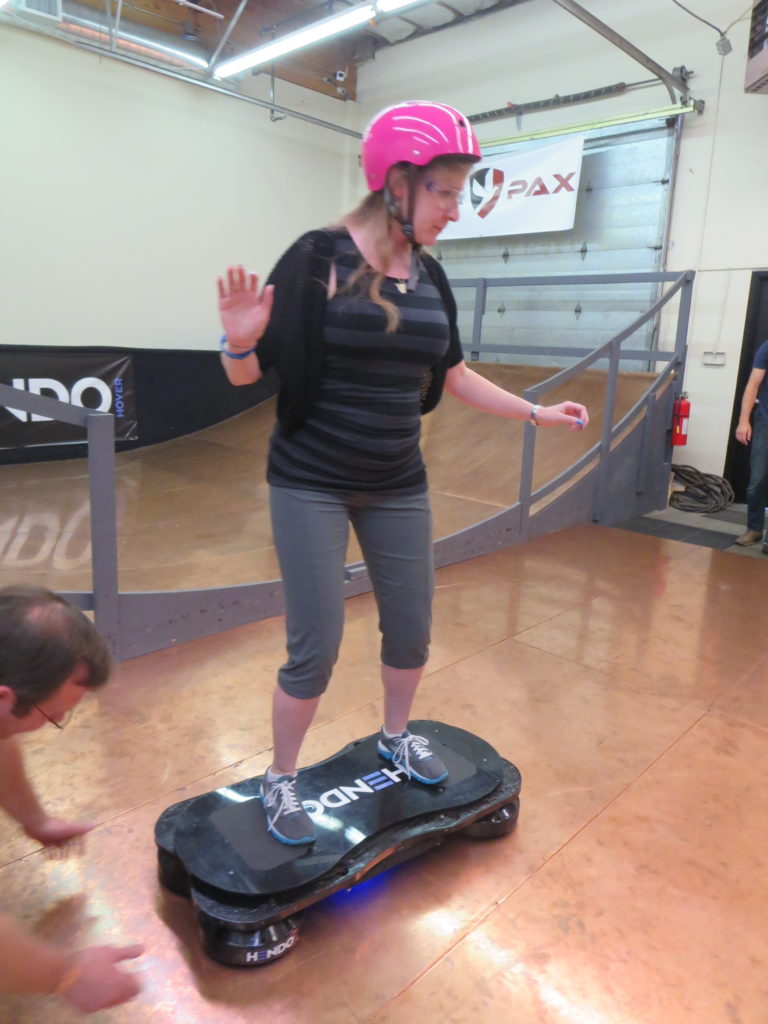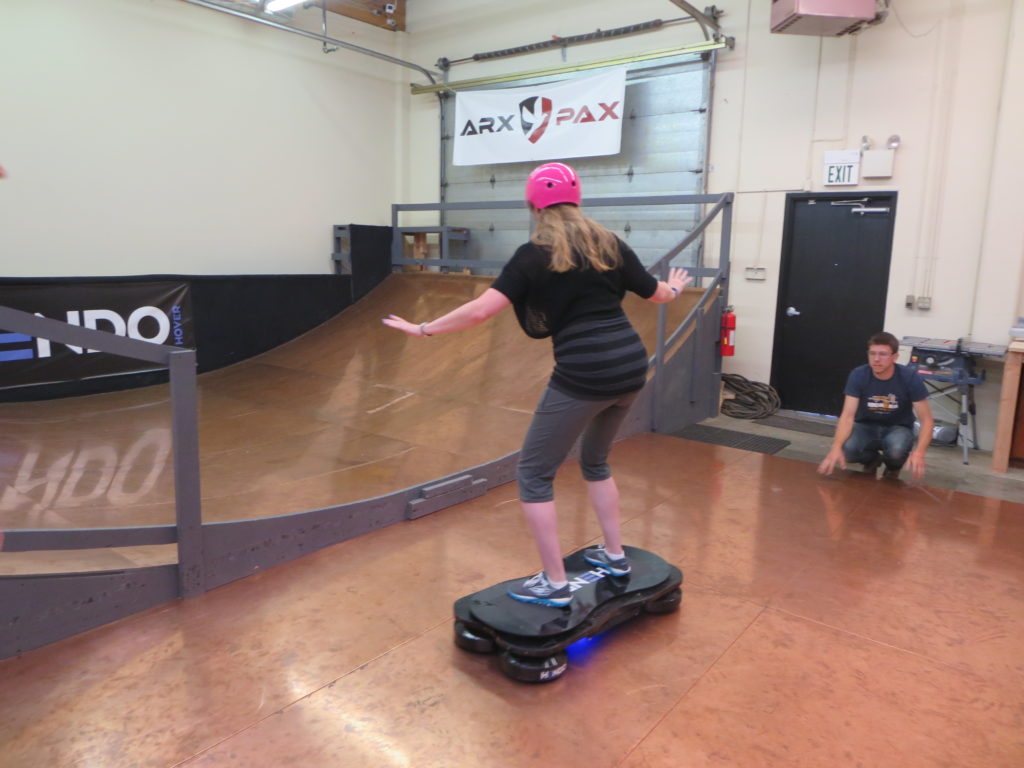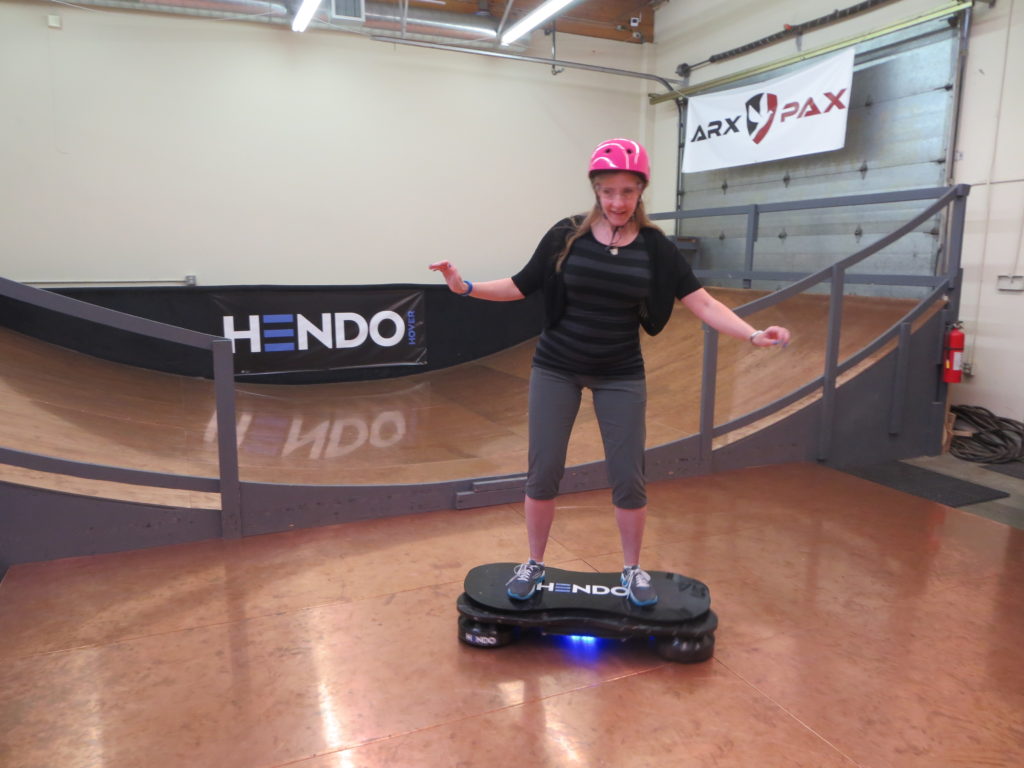About a year ago, shortly after I began my tenure at Amazon and bi-monthly trips to the South Bay Area, I stumbled upon yet another Kickstarter. My Kickstarter portfolio has included books, drink-cooling devices, card games, video games, a design school, and in one case geeky baking sprinkles. All successfully funded, though many late deliveries.
This project, however, was much loftier. The video tugged at the heartstrings of my generation, raised from an early age on Back to the Future – early enough that we were forgiving of the sins of Back to the Future II. Specifically, this Kickstarter from a company called Hendo dangled the tantalizing possibility of real, honest-to-God hoverboard technology.
The reward levels were heavily stratified – several thousand dollars for a dev kit, attendance at the launch party, or ownership of your very own board. And yet, for a measly $100, you could theoretically buy yourself 5 minutes on a board in their lab sometime after March 2015.
As I age, I find myself collecting experiences far more than physical goods (with the exception of Pokemon, but I shall not discuss that weakness here.) And that’s the problem with many Kickstarters – for your average backer, it’s just a bunch of stuff. This was different. And with my new job, I knew I’d likely be flying down anyway. The project seemed less likely to succeed than much of my Kickstarter portfolio, but with the likely free trip I felt it worth the risk, and I pledged – not expecting it to come to fruition.
In early 2015, I received the “stuff” part of my backing – a T-shirt, a sticker. I suspected that would be where it ended.
And then – on April 1st, of all days, I received a personal mail from an administrator at Hendo.
“Action Required!! First, we wanted to thank you again for being one of our supporters. We are looking forward to having you here with us to ride our Hendo Hoverboard! … Our calendar is filling up quick so we would like to hear back from you by 4/6 on a desired time slot and a month that you would like to come down to the Arx Pax Headquarters.”
Admittedly, I was a bit shocked – and a bit skeptical. April 1st? Really? Still, I replied within a half hour with some proposed dates. I’d had Kickstarters with simple card games come in a year late. How could it be possible that a HOVERBOARD was being delivered on time?
And yet. Hours later, I was confirmed for a timeslot in June. I ended up having to move it once – but on the afternoon of June 11th, I found myself driving at the end of a business trip to a nondescript business park in the South Bay, surrounded by other nondescript scientific offices.
Since scheduling my appointment, I’d gone back to the Kickstarter page to verify what, in fact, I had signed up for. My pledge level entitled me to “up to 5 minutes on a hoverboard.” I naturally assumed it’d be a small group of folks, and wondered who the fellow backers would be who’d be accompanying me. I wondered if the whole thing could honestly be for real.
When I buzzed into the lobby, the receptionist greeted me by name, had me sign some liability forms and an NDA regarding any accidental viewing of the trade secrets behind the hover technology (which I didn’t end up accidentally viewing anyway).
Soon after, a friendly gentleman in a black shirt and jeans from the Arx Pax business development team came out to greet me and to take me on the tour. He explained that I was the only person on the tour that day. I was shocked and delighted, to say the least. The tour was quick, since the team isn’t too large and there’s a lot they can’t show without tipping their hats – but imagine my delight to meet a woman engineer on the engineering team. She joined us shortly thereafter in the demo environment.
Through large metal double doors with very prominent warnings about powerful electromagnets and harm to electronics was the demo environment – a modified loading dock with high ceilings and unfinished beams. The entry hallway boasted a museum of sorts hung high on the wall – previous prototypes, inasmuch as they didn’t show any proprietary technology. The number of form factors and shapes they’d explored was fascinating. I was shown to a table with safety glasses and helmets as they finished charging the board.
The demo area itself is a miniature skater’s half-pipe built out of copper plating, and a large flat copper area for the untrained starter boarders. They’d been clear from the beginning – no beginners on the half pipe! Which was fine by me – I spent 18 months legally handicapped after a catastrophic knee injury, and I’m no Tony Hawk. And it turns out even Tony Hawk is no Tony Hawk when it came to starting on the pipe – the team showed me a video of Tony training, and explained it took a few hours before he could really get going. I should also mention that I have zero skateboarding experience and shattered my kneecap in 2010, so I’m about as far from Tony Hawk as you can get.
I strapped on a pink helmet and safety goggles. With little fanfare, the board was brought out from the secret lab door and placed upon the floor. It resembled, more than anything, Griff Tannen’s hoverboard – big, black, and beefy. They explained that the board required a weightless startup, and so one engineer on either side knelt down, held the device, and one somehow powered it on. Blue lights glowed beneath, and a surprisingly loud sound emanated from the board as the magnetic… whatevers… groaned to life. And just like that, the board was hovering. I seem to remember one of the engineers passing something briefly beneath it, like a magician proving a woman was hovering onstage. I bent over just to see it at level with my own eyes = the board rested on nothing, an inch off the ground
Then, I realized that they weren’t planning on showing off their own skills yet. They were holding the board for me. “Are you ready?” the lead engineer asked. Up until that point, my ability to hover was like Schroedinger’s box. I could be great. I could be dreadful. Faceplanting on a sheet of metal would hurt in more ways than one.
But opportunity is not a lengthy visitor. And thus I walked over, took a breath, and stepped onto my first hoverboard.


In that first wobbly crossing of the flat copper floor, I learned that friction is your friend. Without the force feedback to tell your brain the effect your weight shifts have on the board, it’s far too easy to overcorrect (and in reality you generally have to shift your weight in an unintuitive direction.) Rather than use one’s foot to push off, the thickness of the board means it’s easier to have someone else give you a push for starter momentum. And once you’re moving, the need for balance is constant.

Surprisingly, my mid-foot strike Skechers sneakers (which I adore) made things a bit more challenging, as it made me more sensitive to wobbles in the board. You can see me rocking back and forth on the board in the video. If I were to do it again, I might wear my “barefoot” running shoes or even dance shoes that give my heel and toe equal purchase.
We did a first short round and took a break to watch some videos of other hoverboard users before coming back for one longer session. The batteries on the board don’t last long yet, but I got to use the full charge since I was a solo visitor. (Unexpected luxury!) In the second round, we practiced stopping and spinning the board (verrrrry slooooowly).
It’s very hard to steer without friction to play with, and more than once I ended up hitting the lip of the halfpipe, stopping the board. Interestingly, some movement is enabled by exploiting inconsistencies in the board (it favors one side, so shifting weight towards one side results in a slight spin.) But I am proud to say that I never fell off in any sort of spectacular fashion (though I did, of course, have to step off to regain balance on multiple occasions), and as far as I’m concerned that makes the whole thing a success.

I was also delighted to meet the team and hear their stories first-hand. I love that this small team of people (and it is a small team!) made this a reality. Many had to accept their job blindly due to the secretive work, and I empathized with that, having accepted my Amazon offer for an undisclosed project. Great opportunity often hides behind great risk.
Once the board ran out of batteries beneath my feet, we wrapped by taking a look at a future application of the Hendo technology. I’m not sure it’s public knowledge, so I’ll refrain from describing it here. But I was inspired by the possibility it represented. There’s more than half-pipes in their future if all goes well. After a few final posed pictures, we parted ways.
In just a few days, Hendo will be unveiling their next-generation hoverboard, funded by the Kickstarter campaign earnings. I’m sure the version I rode will soon be mounted on the wall in their ad-hoc hall of fame. I hope the noise is a bit under control, and hopefully battery life is increased. But it will likely never become commonplace – unless sidewalks become conductive surfaces, in which case…
But as far as Kickstarter experiences go, being one of the first few hundred human beings to ride a hoverboard is going to be hard to beat. My family was REALLY into the Back to the Future trilogy. The trilogy releases were a Big Deal. Went to Universal Studios when the (terrible) BTTF ride opened and waited 3 hours in line. But never did I think while watching that I’d be one of the first to ride a functioning hoverboard.
And the egalitarian nature of the experience was interesting to me, too – that pledge level was open to everyone, and the price was reasonable as experiential rewards go. Admittedly, $100 is a lot to many people, to say nothing of travel costs if needed. But in 1989 when these movies were made, cutting-edge technology wasn’t financed by the public. I suspect only venture capitalists and the wealthy had access to inspiring experiences and technologies in their true infancy. As it turns out, our version of 2015 is slightly more egalitarian.
Sure, our pledges only got us 5 minutes on the board (7 in my case – bonus time!) … but isn’t skydiving a pretty short experience too? And the team made me feel incredibly special and welcome despite my proportionally small contribution. To hear scientists talk about their work in person was a delight.
I left thankful for the opportunity and inspired about the future. But with the oft-cited Back to the Future future almost in the past, it’s time to look forward and dream even bigger. And by that I mean building warp drives. Who wants to launch THAT Kickstarter?
